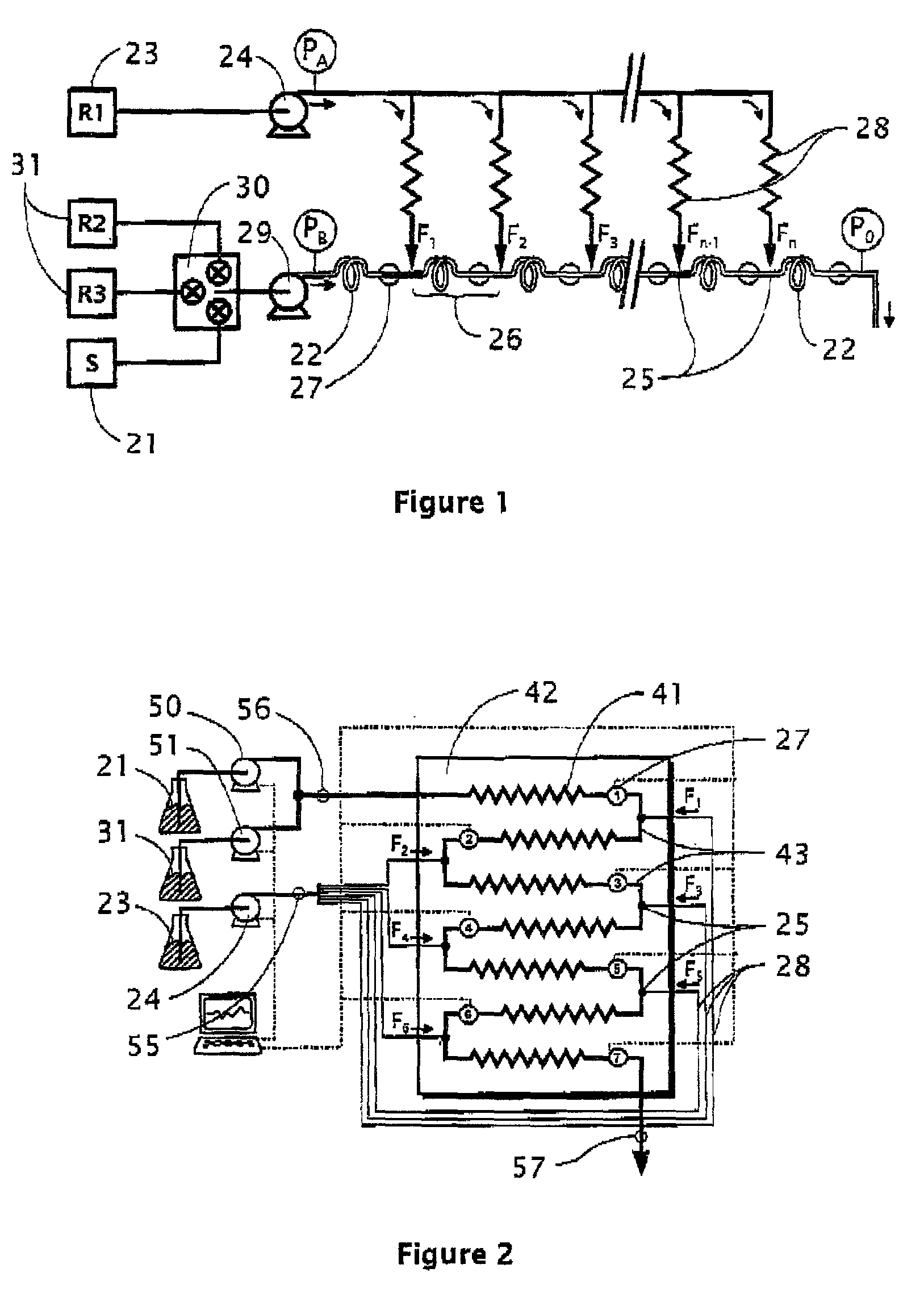Continuous flow titration
a flow titration and continuous flow technology, applied in the field of continuous flow titration, can solve the problems of individual succession, unexpected difficulties, fluctuating end-points, etc., and achieve the effects of improving stability, high degree of experimentation, and increasing the accuracy of endpoint determination
- Summary
- Abstract
- Description
- Claims
- Application Information
AI Technical Summary
Benefits of technology
Problems solved by technology
Method used
Image
Examples
experiment 1
[0069]Referring to FIG. 1, the effect of varying the said pressure difference ratio measured between the titrant delivery point PA and the sample exit point P0 of the conduit with respect to the total pressure difference between the sample delivery point PB and the sample exit point P0 of the conduit is investigated.
[0070]The experimental set-up is schematically depicted in FIG. 2 and a simplified representation of the actual experimental construction is given in FIG. 3. The sample conduit 22 was constructed with a zig-zag mixing channel 41 that was machined into a Plexiglass™ board 42 that ensured a thorough mixing of sample with reagent. Additional channels 43 were machined to allow both internal and external fluid transport to and from the mixing channels 41. The Plexiglass™ board 42 was sandwiched between two metal plates 44, 45 and a rubber gland 46, 47 to seal the top of the channels 41 and to mount external fluidic connectors 48 and detection devices 27. The experimental cons...
experiment 2
[0075]This experiment looks at the effect of proportioning the sample 21 and pre-titrating reagent 31, the range of the titration apparatus, accuracy and stability.
[0076]The experimental set-up is schematically depicted in FIG. 2 and described in Experiment 1, however in this experiment the apparatus utilizes a conduit comprising twelve individual sectors 26 utilizing eleven consecutive titration reagent entrance positions 25 and twelve detection devices 27. The titrating and pre-titrating reagent 23, 31 is 10 mM NaOH with 1×10−5 M Bromothymol blue indicator. The titrant flowrate was 0.25 mL.min−1, corresponding to an average flowrate of approximately 23 μL.min−1 at each consecutive titration reagent entrance position 25, and the combined flowrate of sample 21 and pre-titrating reagent 31 was 3.75 mL.min−1. The pressure difference (PA−P0) between the reagent delivery point PA and the sample exit point P0 of the conduit was approximately 70 bar and the pressure difference (PB−P0) bet...
experiment 3
[0081]This experiment looks at the implementation of a feed back controller in order to automatically control the proportioning of sample and pre-titrating reagent based on a continuous monitoring of the end-point.
[0082]The experimental set-up used in this experiment is the same as that used in experiment 2, however the control of the pre-titration is automated by the implementation of a fuzzy logic controller (FLC) based on a monitoring of the end-point, as demonstrated in FIG. 5. The titrating and pre-titrating reagent used was 0.01 M NaOH with 5×10−5 M Bromothymol blue indicator. The sample was an acetic acid solution whereby the concentration could be either kept constant or varied, either gradually or suddenly, the operator manually determining the rate and extent of the sample concentration change.
[0083]The result of the continuous titration, performed over a period of 24 hours, is given in FIG. 6. During this time interval, 49 297 consecutive titrations were logged. The stabi...
PUM
 Login to View More
Login to View More Abstract
Description
Claims
Application Information
 Login to View More
Login to View More - R&D
- Intellectual Property
- Life Sciences
- Materials
- Tech Scout
- Unparalleled Data Quality
- Higher Quality Content
- 60% Fewer Hallucinations
Browse by: Latest US Patents, China's latest patents, Technical Efficacy Thesaurus, Application Domain, Technology Topic, Popular Technical Reports.
© 2025 PatSnap. All rights reserved.Legal|Privacy policy|Modern Slavery Act Transparency Statement|Sitemap|About US| Contact US: help@patsnap.com



